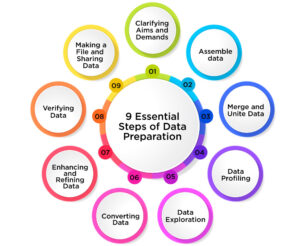Have you ever considered how unprocessed data might be transformed into insightful knowledge? This is when data preparation becomes important. This process involves cleaning and transforming data to make it ready for analysis. Though it takes time, it’s important for accurate results. Data engineers and businesses rely on data preparation to ensure their data is reliable and useful.
This blog discusses the meaning, steps, and benefits of the data preparation process. Let’s learn together.
What is Data Preparation?
The procedure during which cleaning and transformation of unprocessed data takes place before processing and analysis step is known as data preparation. It is a very crucial process. During this process, data reformatting takes place, some of the corrections in data are made, and for the purpose of enriching data, the datasets are combined.
To get proper results after analysis of data, it is essential to perform the data preparation process. It is true that it is a time-consuming process, but putting data into context is important, too. So, data engineers and businesses embrace data preparation steps, although they are lengthy processes.
9 Essential Steps of Data Preparation
- Clarifying Aims and Demands
To clarify the aims and demands of the data analysis project, ask questions such as what hypotheses to test, what level of accuracy is expected, what data quality is required, etc. Answer these questions properly so it will help us proceed. - Assemble data
Use all possible sources to assemble data. Use of the right tools and methods is important. By doing so, you will identify your business problem appropriately. Even the bias is minimized, which will increase the reliability of your data. - Merge and Unite Data
Data integration is the process through which you can merge and unite your data. - Data Profiling
Data profiling is an analytical approach to studying the properties, quality, structure, and content of a dataset; it also guarantees that data quality standards are maintained within the company and provides insights on variations in data and uniformity, including null values, through the examination of source data. - Data Exploration
To find patterns, trends, outliers, and anomalies in data, data exploration entails learning about and categorizing the data. Assessing data quality and appropriateness for analysis is made simpler by it. Data distributions may be understood using visualizations such as scatterplots, boxplots, and histograms. - Converting Data
The process of converting data from one format to another is known as conversion. This process makes analysis easy, and data becomes compatible. - Enhancing and Refining Data
Data enrichment is the process used to enhance and refine data. It adds new features and columns to improve the accuracy and reliability of data. Combining various data sources, segmenting the data, creating new features, fixing missing values, classifying the data, identifying entities, and using cleaning, validation, and enrichment techniques are all part of it. - Verifying Data
The data validation process verifies data prior to the finalization of data for consumption. By using set specifications and requirements that represent your needs, standards, and regulations, data validation will allow you to verify the accuracy of the data. - Making a File and Sharing Data
Data documentation is the last step, in which data is filed properly and then shared. Formats, definitions, types, and descriptions are used. So, data becomes accessible and usable for others.
Benefits of Data Preparation
Data preparation is important for data scientists and other end users to focus on data mining and analysis, which generate business value.
- Proper data preparation ensures reliable results.
- It identifies and fixes data issues.
- It enables informed decision-making.
- It reduces data management and analytics costs.
- It avoids duplication of effort.
- It increases the ROI from BI and data science initiatives.
- It is especially beneficial in big data environments that store a combination of structured, semi-structured, and unstructured data for machine learning and predictive analytics.
A well-managed data preparation process helps rectify the time-consuming nature of preparing data for machine learning.
Wrapping Up!
Proper data preparation is key for data scientists and end users to focus on valuable analysis. It ensures accurate results, fixes data issues, and supports informed decision-making. Also, it cuts down on data management costs, prevents effort duplication, and boosts the return on investment from data initiatives.
In big data environments, effective data preparation is especially helpful for machine learning and predictive analytics, making the process smoother and more efficient.
This discussion explores data preparation in detail, and we hope it adds to your knowledge. For more tech-related insights, keep visiting HiTechNectar.
Read More: Data Privacy and Security in the Tech-Driven Economy: How To Balance Innovation with Legal Compliance



